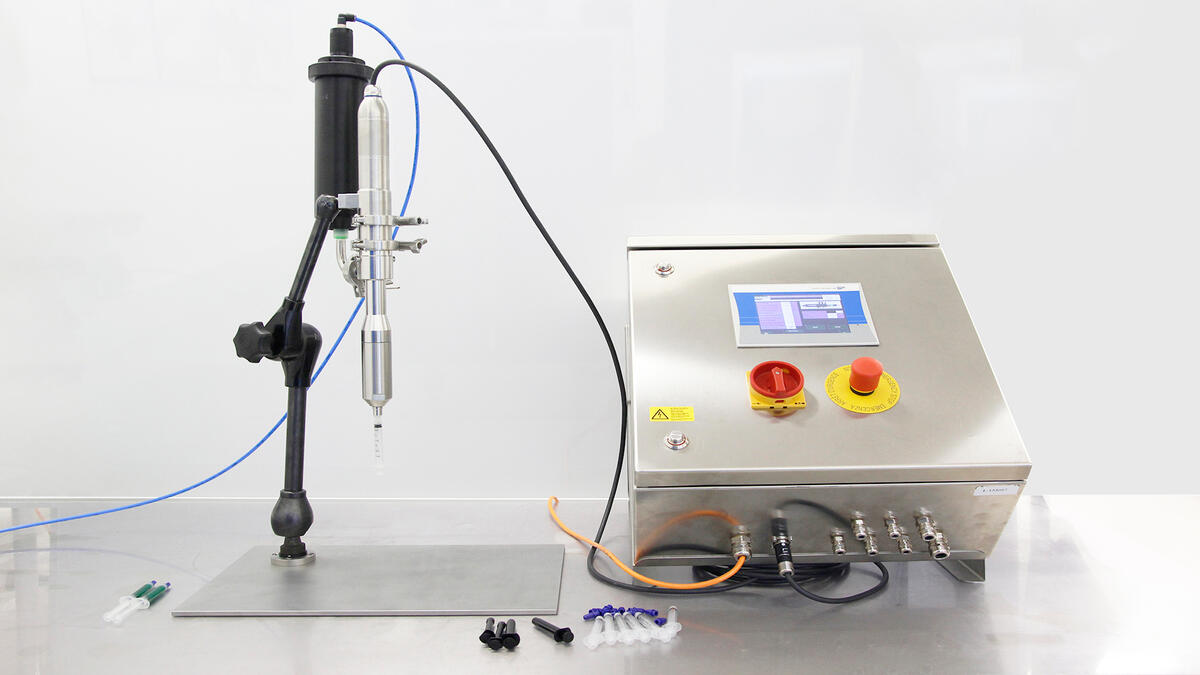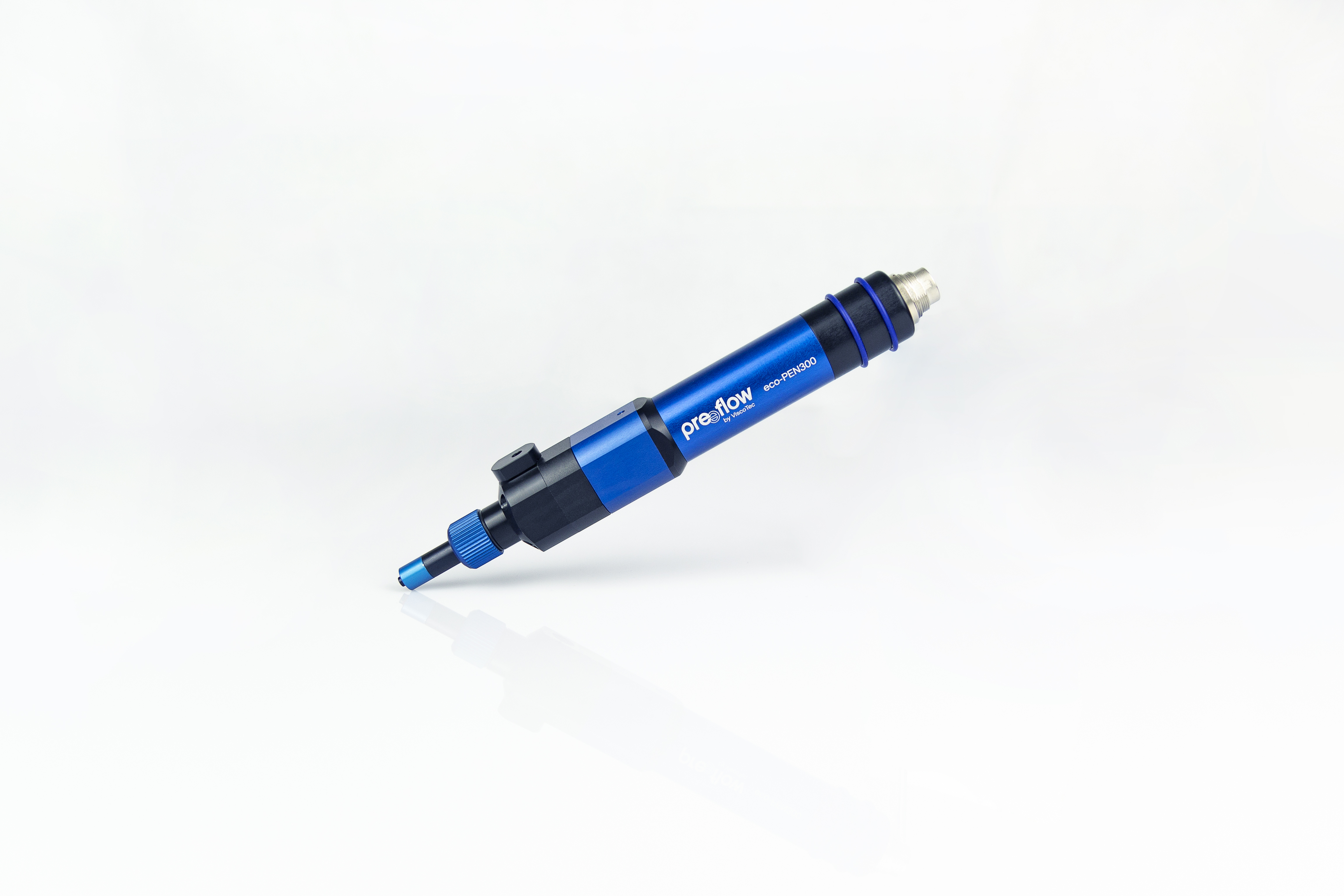Automated grease application – precise and reliable
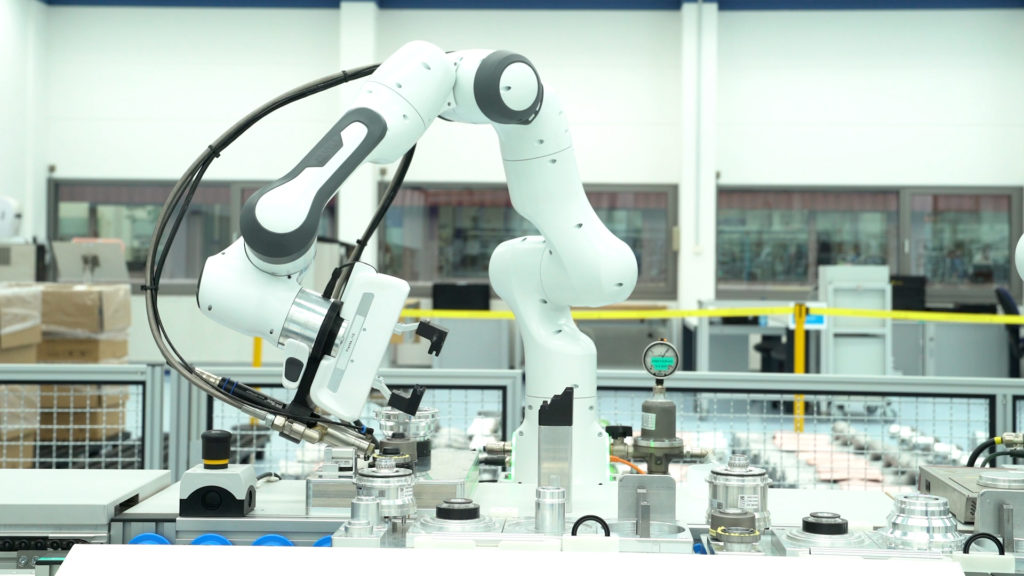
TQ Systems, in Durach, manufactures collaborative robots that assemble themselves – among other things, with the help of preeflow dispensing technology. The precise eco-PEN and eco-SPRAY dispenser systems take care of the lubrication of gears, for example. The basic idea of letting the robots build themselves arose at TQ from the question: There is manual production and full automation – but what is in between? How can companies become more productive while remaining flexible and cost-effective?
The lightweight robots are perfect for partial automation. They make an impression with their ability to detect forces, as well as their simple usability. TQ Systems customers can “program” the robots themselves. This keeps them flexible and allows them to easily adapt the steps for new products – due to a user interface that resembles a cell phone application, the robot arms can be “reprogrammed” very easily: With individual function blocks that are connected in series. Anyone who can operate an iPhone can also operate these robots. TQ’s customers are not primarily integrators, but technicians and assembly workers without programming skills. In other words, typical SMEs who want to automate without too much financial investment. The focus is always on functionality and operability.
Until Franka Emika developed the collaborating robot, and TQ Systems took over the production, no robots were used in production. Automation had simply not been worthwhile. Ever since May 2017, TQ has had a classic manufacturing contract with Franka Emika; and in the process, it was recognized that it can very well be worthwhile to use these robots to advance one’s own automation. The result is a highly productive line. The employees at TQ acquired the necessary knowledge for this themselves.
The following steps are implemented by the robots:
- Screwdriving automation: The screws are inserted manually; a Panda robot screws them tight. The result is of a higher quality than a completely manual process.
- Testing of electronics: Each component is tested individually during production. Until now, this was a manual process. From now on, the robot can do this by itself, with the help of a camera system.
- Spraying: A gearbox is sprayed with grease. In the previous manual process, the application of the lubricant was relatively imprecise. Here an eco- SPRAY dispenser is used and exceeds expectations.
- Dispensing: A bead of grease can be dispensed into joints or robot axes. Here an eco-PEN dispenser is used.
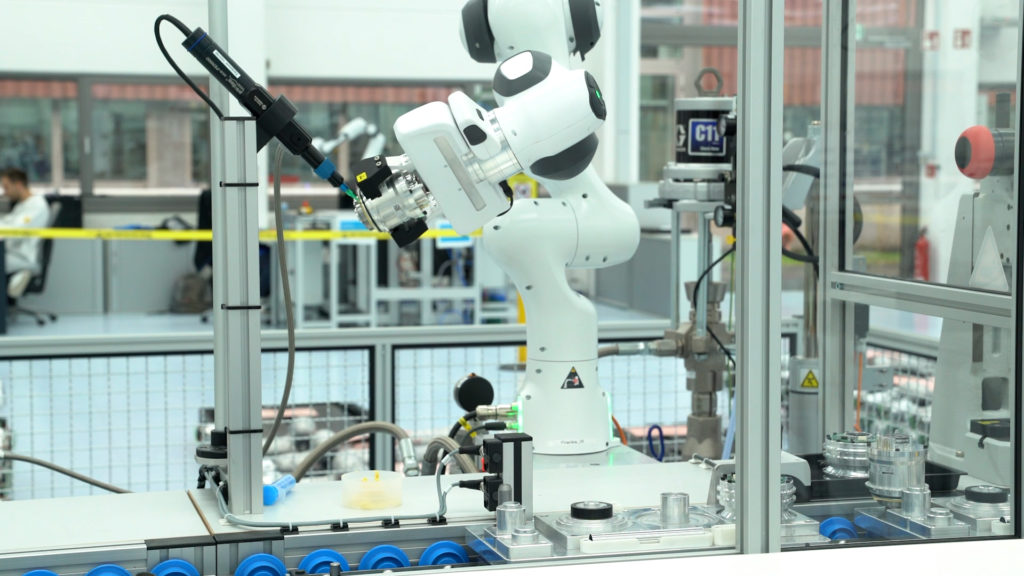
Due to the cooperation of the robots with the proven preeflow dispensing technology, both spray application and greasing are now clean and process safe. The precise micro-dispensing systems were already in use at TQ as axis portal for various customers. Until now, they have not been used in combination with the robots. But due to the well-earned experience with the dispensing systems in various customer applications, both systems were combined with each other: The specification for the dispensing technology to be used was a dispensing that had to be accurate to a tenth of a gram. And it had to be absolutely reliable and repeatable. This is what Sören Brüchmann, business unit manager of TQ Robotics, has to say on production before automation: “Essentially, we had a manual production in which lubrication had to be implemented very precisely. One employee applied grease in the tenth of a gram range using a time-pressure system and with the help of a scale”. But this was exactly where the weak areas were: On the one hand, there was the issue of speed. The purely manual application and control via a scale often resulted in time delays. On the other hand, there was the issue of dispensing precision – where on the component should the grease really be applied? This was a particularly important step, but it could not be done by hand with such precision. Hence the approach: How can this step be automated? Either with regard to the exact application quantity, or in view of process accuracy and ultimately the quality of the end product. “Our goal was to use the preeflow dispensers to dispense the materials with absolute repeatability and to apply the exact dispensing quantity in exactly the right place”. Brüchmann continues. Due to their experience with preeflow, TQ was able to convince itself of the quality and reliability of the dispensers early on and knew that the dispensers were perfectly suited for its purposes. The targets were met and implemented perfectly.
At the moment we use an eco-SPRAY and an eco-PEN dispenser, as well as flowplus and flowscreen dispensing technology. In addition to the positive experience with the precision dispensers, the issue of regionality also played a role in the decision. preeflow products are “Made in Germany”, just like the robots, which are developed and manufactured by TQ in Germany. “We would like to use regional, high-quality systems that deliver what they promise – that’s why we chose preeflow,” says Sören Brüchmann.
The following video gives an insight into the production processes at TQ, which were automated using the preeflow dispensers:
Kundecase: Automatiseret fedtpåføring – præcist og pålideligt med udstyr fra preeflow
TQ Systems fremstiller collabarative robotter, der samler sig selv – blandt andet ved hjælp af preeflows dispenseringsteknologi. De præcise dispensersystemer eco-PEN og eco-SPRAY sørger for eksempel for smøring af gear. Grundideen med at lade robotterne bygge sig selv opstod hos TQ ud fra spørgsmålene: Der er manuel produktion og fuld automatisering – men hvad er der imellem? Hvordan kan virksomheder blive mere produktive, mens de forbliver fleksible og omkostningseffektive?
Følgende trin implementeres nu af robotterne:
- Automatiseret skruning: Skruerne indsættes manuelt; en robot skruer dem fast. Resultatet er af højere kvalitet end en fuldstændig manuel proces.
- Test af elektronik: Hver komponent testes individuelt under produktionen. Indtil nu var dette en manuel proces. Fra nu af kan robotten gøre det alene ved hjælp af et kamerasystem.
- Spray: En gearkasse sprayes med fedt. I den tidligere manuelle proces var påføringen af smøremidlet relativt upræcis. Her bruges nu en eco-SPRAY-dispenser og resultatet overgår forventningerne.
- Dispensering: En fedtperle dispenseres i samlinger eller robotakser. Her bruges en eco-PEN dispenser
På grund af robotternes samarbejde med den gennemprøvede dispenseringsteknologi fra preeflow er både spraypåføring og smøring nu rent og processikkert.
Vores preeflow mikrodispenseringssystemer var allerede i brug hos TQ i diverse kundeapplikationer inden automatiseringen, men det er først fornyligt, at de er begyndt at blive brugt i kombination med robotterne. Og på grund af de gode erfaringer fra tidligere brug, blev begge systemer altså kombineret med hinanden:
Specifikationen for dispenseringsteknologien, der skulle bruges, var en dispensering, der skulle være nøjagtig til en tiendedel gram. Og det skulle være absolut pålideligt og gentageligt.
TQ siger: ”Vores udgangspunkt var, at vi havde en manuel produktion, hvor smøring skulle implementeres meget præcist. En medarbejder påførte fedt i det tiendedels gram interval ved hjælp af et tidstrykssystem og ved hjælp af en vægt”. Men det var netop her, hvor de svage områder var: På den ene side var der spørgsmålet om hastighed. Den rent manuelle anvendelse og kontrol via en vægt resulterede ofte i tidsforsinkelser.
På den anden side var der spørgsmålet om dispenseringspræcision – hvor på komponenten skal fedtet påføres? Dette var et særligt vigtigt skridt, men det kunne ikke gøres manuelt med den nødvendige præcision.
Derfor spurgte TQ sig selv: Hvordan kan dette trin automatiseres? Enten med hensyn til den nøjagtige påføringsmængde eller i betragtning af procesnøjagtighed og i sidste ende kvaliteten af slutproduktet. ”Vores mål var at bruge preeflow dispenserne til at dispensere materialerne med absolut repeterbarhed og anvende den præcise doseringsmængde på det nøjagtige sted”. På grund af TQ’s tidligere erfaring med preeflow var virksomheden i stand til at overbevise sig selv om dispensernes kvalitet og pålidelighed tidligt i processen, og vidste derfor, at dispenserne var perfekt egnede til formålet. Målene blev opfyldt og implementeret perfekt.
I øjeblikket bruger TQ en eco-SPRAY og en eco-PEN dispenser samt flowplus og flowcreen dispenseringsteknologi. Videoen ovenfor giver et indblik i produktionsprocesserne ved TQ, og viser vores preeflow dispensere i action.
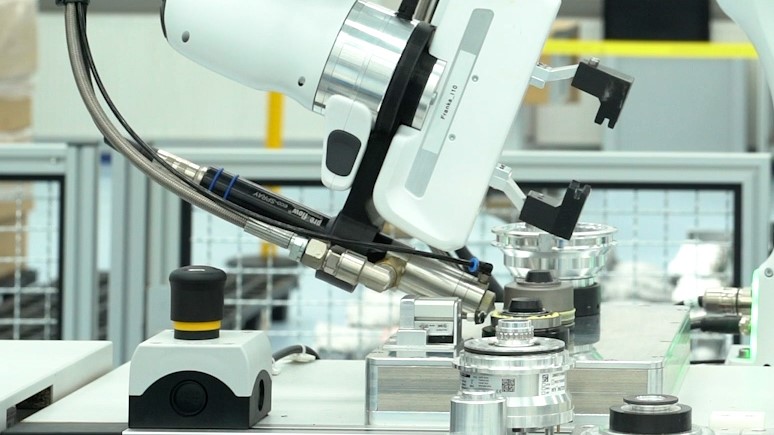
Kundfall: Automatiserad fettapplikation – exakt och pålitlig med utrustning från preeflow
TQ Systems tillverkar samarbetsrobotar som monterar sig själva – bland annat med hjälp av dispenseringsteknik före flödet. Exakta dispensersystem eco-PEN och eco-SPRAY ger till exempel smörjning av växlar. Grundtanken att låta robotarna bygga sig uppstod vid TQ baserat på frågorna: Det finns manuell produktion och full automatisering – men vad är däremellan? Hur kan företag bli mer produktiva samtidigt som de förblir flexibla och kostnadseffektiva?
Följande steg implementeras nu av robotarna:
- Automatisk skruvning: Skruvarna sätts in manuellt; en robot skruvar fast dem. Resultatet är av högre kvalitet än en helt manuell process.
- Test av elektronik: Varje komponent testas individuellt under produktionen. Hittills var detta en manuell process. Från och med nu kan roboten göra det ensam med ett kamerasystem.
- Spray: En växellåda sprutas med fett. I den tidigare manuella processen var appliceringen av smörjmedlet relativt felaktig. Här används en eco-SPRAY-dispenser och resultatet överträffar förväntningarna.
- Dosering: En fettstråle fördelas i fogar eller robotaxlar. En eco-PEN-dispenser används här
På grund av roboternas samarbete med den beprövade dispenseringstekniken före flödet är både sprutapplicering och smörjning nu rena och processäkra.
Våra preeflow smikrodispenseringssystem användes redan vid TQ i olika kundapplikationer före automatisering, men det är först nyligen som de har börjat användas i kombination med robotarna. Och på grund av de goda erfarenheterna från tidigare användning kombinerades båda systemen med varandra:
Specifikationen för dispenseringstekniken som skulle användas var en dispensering som var tvungen att vara exakt upp till en tiondels gram. Och det borde vara helt pålitligt och repeterbart. TQ säger: ”Vår utgångspunkt var att vi hade en manuell produktion där smörjning måste genomföras mycket exakt. En anställd applicerade fett i det tionde gramområdet med hjälp av ett tidstryckssystem och med en skala”. Men det var just här som de svaga områdena var: å ena sidan var det frågan om hastighet. Den rent manuella användningen och kontrollen via en skala resulterade ofta i tidsfördröjningar. Å andra sidan var det frågan om doseringsprecision – var på komponenten ska fett appliceras? Detta var ett särskilt viktigt steg, men det kunde inte göras manuellt med nödvändig precision.
Därför frågade TQ sig själv: Hur kan detta steg automatiseras? Antingen i termer av den exakta appliceringshastigheten eller när det gäller processens noggrannhet och i slutändan kvaliteten på den slutliga produkten. ”Vårt mål var att använda förflödesdispensrarna för att dispensera materialen med absolut repeterbarhet och applicera den exakta dosmängden på den exakta platsen”. På grund av TQs tidigare erfarenhet av förflöde kunde företaget övertyga sig om dispensers kvalitet och tillförlitlighet tidigt i processen och visste därför att dispensrarna passade perfekt för ändamålet. Målen uppnåddes och genomfördes perfekt.
För närvarande använder TQ en eco-SPRAY och en eco-PEN dispenser samt flowplus och flowcreen dispenseringsteknik. Videon ovan ger en inblick i produktionsprocesserna på TQ och visar våra förflödesautomater i aktion.
Categories
- Animals (1)
- Design (5)
- Dispensers (38)
- Dopag (8)
- Events (3)
- Markets (1)
- Meter Mix (8)
- Music (1)
- News (4)
- Precifluid (4)
- Preeflow (35)
- Travel (4)
- Uncategorized (9)
- Viscotec (40)

